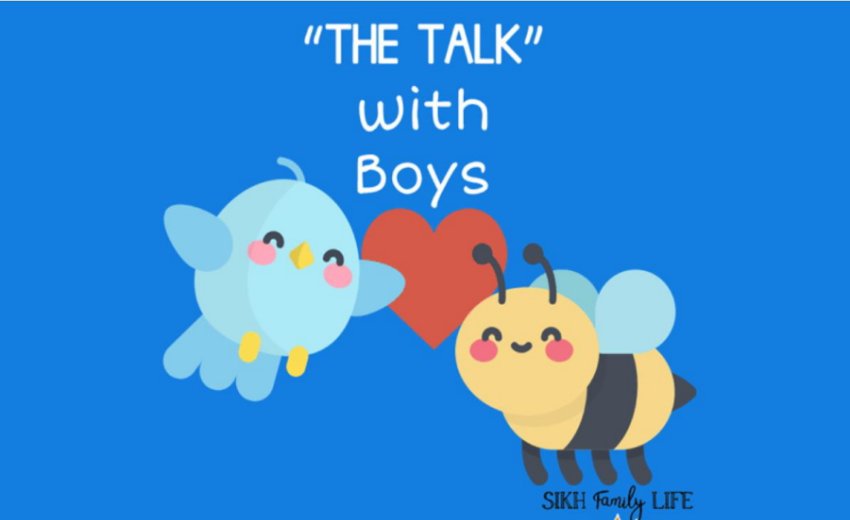Nov 30, 2018: Two weeks ago, I wrote about what steps we can take to deter our daughters from engaging in activities that aren’t in line with Gurmat: this week, we review how to encourage our sons in their Sikhi and give some ideas on how to get the conversation started about Dating. If you haven’t already done so, I encourage checking out the first part that was aimed at educating our daughters, because truly, the pointers shared in that post apply equally as much to our young Singhs.
Opening the lines of communication
It’s massively important that we open the lines of communication as early as possible. This way, when we broach the subject of dating, sex, and Sikhi, it’s not as uncomfortable as it would be if we generally NEVER speak about Sikhi and the current social issues our young people face. As shared previously, start from a young age with Sakhis and from about fourth grade onwards, do weekly Gurbani Veechar WITH our kids (for more info about these points, see this post). Of course, we can only speak knowledgably about such things if we ourselves are educated or have the giyaan to do so. This means that we too, must seek out answers for ourselves and seek them from the most perfect source of wisdom: Guru Ji! In other words, we must model what it means to be a Sikh if we hope that our children will also follow suit.
“The Talk” with Boys
All the points given in the previous post, apply here when addressing our boys, too. Here are more pointers to frame and focus the conversation:
1. Start with WHY. Every Sikh should be able to express what is the purpose of having a human life. When we know what our life’s purpose is, then we can strategically plan our present and future to work towards our life’s goal. Moreover, if we have a firm grasp of our aim, we then possess a barometer of sorts that we can use to see if what we’re doing is of value and of service towards our ultimate purpose. Potential discussion questions include:
- What are your life dreams?
- What are your goals in life?
- What are you doing right now to accomplish your goals and dreams?
- What is the purpose of life?
- What are you doing right now to accomplish your life’s purpose?
It’s extremely important to note that these questions are incredibly personal. A big tip to help our children open up to us is to be honest with them and share some of our life dreams and goals, too. That way, it won’t seem like we’re just interrogating our kids for information and we’ll have more of a relaxed (hopefully insightful) discussion. Also, it’s important that we don’t minimize or trivialize their aspirations. That’s a quick way to get our kids to shut down or to shut us out (emotionally) of their lives. Here, validating their feelings and using our active listening skills will help immensely (see previous post for more in-depth pointers on validation and active listening).
2. Ask about their relationship… With Guru Ji! Have a discussion about what our relationship is to our Guru. It’s always incredibly fascinating how each of us has such a unique relationship with Guru Ji and don’t assume that our kids will see Guru Ji in the same way we view our Guru. Ask:
- How do you view your personal relationship with Guru Jee?
- If they need additional help, maybe prompt by asking, “Do you mainly see Guru Ji as your…”
- Friend?
- Best friend?
- Teacher?
- Doctor?
- Savior?
- Warrior?
- Protector?
- King (of Kings)?
- Mother?
- Father?
- Brother?
- Master?
- Boat?
- Architect?
- Destroyer (…of pain, sadness, doubt, fear)?
- Giver?
- … and the list can go on forever!
We don’t have to list every single one of these options, but a few just to get kids to think about how they conceptualize Guru Ji or, better yet, how have they experienced Guru ji in their lives? Again, since we’re having this conversation WITH our kids, we should also think about this deeply for ourselves and try to put this into words so our kids can understand US better. Sharing some personal experiences we’ve had with Guru Jee might do wonders to illustrate for our kids how we view our relationship with Baba Ji. It may also help our children share more with us. To a certain extent, the more vulnerable we can be with our kids, the more vulnerable they can be with us. Of course, there are some things that are only meant for other adult ears and ideally, we’ll know where to draw the line when sharing with our kids.
3. No matter our relationship with Guru Jee, we must acknowledge Guru Ji as the Supreme Source of Knowledge, Love, and basically, that He’s ALWAYS got our backs (aka our best interests at heart)! Knowing this for ourselves and expressing this idea to our children will set up the next part of “The Talk” – the actual advice Guru Ji gives on Kaam, sexual relations, (dating &) marriage, and Sikhi. In fact, it’s even better if kids are the ones to express this sentiment for themselves. Questions to ask include:
- Does Guru Jee really have our backs?
- Why do bad things happen to us, then?
- Does Guru Ji really know EVERYTHING?
The best way to answer these questions is actually through Gurbani – let Guru Jee answer these questions for us, AFTER hearing what our sons think (and us validating their feelings as we practice active listening!). Guru Ji LITERALLY knows EVERYTHING and has ALL the answers! These hard-hitting questions are best answered through some form of Gurbani Veechar.
4. We have to trust Guru Jee when Guru Ji gives us advice for EVERY aspect of our life, including how to handle kaam and relationships. Yup – it’s true: Guru Ji has relationship advice for us! But before diving into Guru’s advice, it’s important to get a handle on and understanding of what our young Singhs think of dating, sex, and relationships. Questions to prompt discussion include:
- What do you think Guru Jee thinks about dating?
- Do you think Guru Ji says dating is ok?
- Are there some circumstances in which Guru Jee would be cool with it?
- What are some words that pop into your head when you think of dating? Tips for this particular question:
- This can be turned into a show-off activity – not to mention super insightful and a great way to educate our kids on sexual relations. Ask our Singhs to brainstorm WITH us, for 5 minutes, words they associate with dating.
- Write down EVERYTHING that comes up, even if the F-word comes up, or various other sexual acts come up that are slang words for sex or oral sex. If they’re hesitant to mention kissing or sex and it’s been a minute, WE should mention it to write it down. They might be shy initially, but after we open the door to them, and demonstrate that we’re “with it” and know that kids are doing these kinds of things, they might be more open to sharing what else they associate with dating.
- Note: I’ve done this activity before with a group of boys and girls and I was completely surprised and at the same time, somehow not really surprised (when I thought about the stuff I knew when I was in fifth grade) at just how much our kids know! They were also pretty proud to show off how much they know about these often taboo-to-talk-about behaviors.
5. Now, what does Guru Jee actually say?: Kaam and sexual relations are 100% for AFTER marriage. THERE IS NO DATING IN SIKHI, as harsh as it sounds. And once we review what Guru Ji says about sexual relationships and after going through a word-association activity related to the word “dating” with our kids, hopefully it’ll be clear why dating is off-limits for Sikhs.
Guru Gobind Singh Ji shares in Dasam Granth (in Charitropakhyaan) that when He, (Guru) Gobind Rai, was of an age in which He could understand this topic of sex, Guru Tegh Bahadur Ji approached Him and said to promise me that as long as you have breath in your body, with your own wife, you are allowed to (emotionally and physically) increase your love … BUT, with any another woman, don’t even, in your DREAMS, go into another her bed, even by mistake! The actual Gurbani is:
sudh jab te ham dharee bachan gur dhe hamaare ||
When I reached an age of maturity, my Guru told me:
poot ihai pran toh praan jab lag ghaT thaare ||
“My Son, so long as there is life in your body,
nij naaree ke saath neh tum nit baddaiyahu ||
“You promise to enhance and build love with your own wife,
par naaree kee sej bhool supane hoo(n) na jaiyahu ||51||
“But never, even by mistake in your dreams, get into bed with someone else’s wife.”(51)
(Dasam Bani, Ang 836)
In fact, when we’ve only had one sexual partner in our whole life (barring something unusual happening like abuse or death of a spouse, etc.) we get the punn or phal of being Jati-Sati (someone who has remained celibate). Bhai Gurdas Ji, the writer and scholar whose works were given the status as the Keys to understanding Gurbani (and consequently, Sikhi), writes:
dhib dhisaT paragaas kar lok vedh gur giaan pachhaanai|
Getting enlightened one identifies the teachings of Guru even in secular affairs
ekaa naaree jatee hoi par naaree dhee bhain vakhaanai|
Having one women as wife he (the Sikh) is a celibate and considers any other’s wife as his daughter or a sister.
(Vaar, Bhai Gurdas Ji)
And Guru Arjan Dev Ji said:
kiaa gaalaio bhoochh par vel na johe ka(n)t too ||
What should I say to you, you fool? Don’t look at the vines of others – be a true husband
naanak fulaa sa(n)dhee vaaR khiRiaa habh sa(n)saar jiau ||3||
O Nanak, the entire world is blooming, like a garden of flowers. ||3||
(Raag Maroo, Mehla 5, Ang 1095)
In other words, Guru Jee tells husbands:
“Don’t look at the vines of others” means don’t look at other’s spouses – be a true husband by tending to your “garden” or your flower, your beautiful wife (hay hay!). This world is FULL of beautiful women (a garden of flowers), and being a true husband means keeping your gaze, your affections, and your kaam focused on your own wifey!
6. Talk directly about what it means to be married and in an Anand Karaj! For talking points, check out our Anand Karaj Series and our Infograpic on The Ideal Anand Karaj! In a nutshell, though, Grist Jeevan is where a man and a woman come together to help each other on this path of Sikhi to merge with the One.
guramukh bhe niraas param sukh paiaa ||
The Gurmukhs become desireless, and attain supreme peace
viche gireh audhaas alipat liv laiaa ||
In the midst of their household, they remain detached; they are lovingly attuned to the Detached Lord.
(Raag Saarang, Mehla 3, Ang 1249)
Remaining detached doesn’t mean remaining distant emotionally or physically from one another – it means something else – check out this post for more info!
7. Don’t jam it all into one conversation! Avoid cramming all this information into one conversation; instead, have a series of conversations that build off of each other, with reminders of what was discussed last time at the start of each next conversation. This not only makes it easier for us to deliver the message but also helps establish regular communication with our kids. It’s also not a one-and-done conversation, meaning that it should be a topic that is revisited every so often – at least once or twice a year. We all need reminders to keep on the straight and narrow – as this most beautiful path, however simple it may be, is incredibly difficult to walk:
bhagataa kee chaal niraalee ||
The lifestyle of the devotees is unique and distinct.
chaalaa niraalee bhagataeh keree bikham maarag chalanaa
The devotees’ lifestyle is unique and distinct; they follow the most difficult path.
(Raag Ramkalee, Mehla 3, Ang 918)
However, if we try our best to walk this most perfect of paths, then Guru Ji says He’ll give us all His support. On the other hand, if we do what most of society is doing and encourages us to do, we’ll not only lose Guru Jee’s happiness with us, but also His support for us:
jab lag khhaalasaa rahe niaaraa ||
As long as the Khalsa remains unique and distinct.
tab lag tej keeau mai(n) saaraa ||
Till then, I will give them all of my radiance.
jab ieh gahai biparan kee reet ||
If they start following the ways of the world.
mai(n) na karo(n) in kee prateet ||
Then I won’t support them at all.
(Guru Gobind Singh Ji on The Khalsa)
This is a critical point to discuss with our children – especially when we tie it back to our purpose of life.
Whew… that was a LOT!
We covered a TON of points in this post on how to approach our sons about this topic of the Gurmat view on dating and sex. However, to get a full scope and all the tips provided on how to get the conversation started, it’s important to read the first part that was more aimed at addressing our daughters. Truly, the talking points provided in these two posts are fabulous for both genders to know and to think about. In other words, the information is not necessarily gender-specific.
It would be SO wonderful if all of our pre-teens and teens, Singhs and Kaurs, received this type of education when they are mature enough to learn about these topics. We should start as soon as we believe they can handle it or whenever school begins to address these topics, which in the U.S. is typically in 4th grade (when kids are 9/10 years old). Kids are exposed to so much these days through social media, TV, Netflix and other online platforms. It behooves us to discuss what they see not only online, but in real life too. Remember, if we’re not having these conversations with our kids, they WILL seek out answers to their questions about these topics or ask their peer group for advice. Put another way: if we don’t have these conversations with our children, they’ll likely talk about this stuff with others… and these others may not have the best advice to give our kids!





